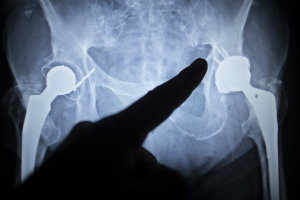
While all artificial hip replacement devices carry risks including wear of the component material, metal-on-metal hip replacement devices have unique risks in addition to the general risks associated with a hip replacement device.
The hip joint is one of the most important joints in our bodies, enabling us to walk, run and jump. It is the second largest weight bearing joint and also one of the most flexible, allowing a greater range of motion than our other joints (except for the shoulder).
In basic terms, the hip joint is a synovial joint; the ball is the femoral head and a round cup-shaped structure known as the acetabulum is the socket for the hip joint. This ball fits into the socket and bands of tissue called ligaments connect the ball to the socket. As you move your legs, the femoral head (the ball) at the top of the femur slides against the acetabulum (the socket) of the pelvis.
Those whose hip joints have become diseased, damaged or worn out from age can develop mobility problems. To gain back mobility, many choose to undergo a hip replacement.
In the United States, there are four types of total hip replacement devices available with different bearing surfaces.
As of May 16, 2016, the effective date of the final order requiring premarket approval applications for these devices, there are no FDA-approved metal-on-metal total hip replacement devices marketed for use in the US. However, there are some patients who received a metal-on-metal total hip replacement prior to May 16, 2016.
The FDA’s Metal-on-Metal Total Hip Replacement Implant webpage provides specific information on metal-on-metal total hip replacements.
MoM hip implants are typically made from a blend of different metals, including chromium, cobalt, nickel, titanium and molybdenum. When the metal parts rub against each other, the release small particles of debris. In addition, metal surfaces can corrode, giving off metal ions. This debris (the particles and ions) can enter the space around the implant and/or the bloodstream causing a reaction such as pain or swelling around the hip.
The FDA has published a page on its concerns about metal-on-metal hip implants.
 Unfortunately, many have suffered serious complications from a metal-on-metal hip replacement.
Unfortunately, many have suffered serious complications from a metal-on-metal hip replacement.
Metallosis. A type of metal poisoning that occurs when toxic levels of metal build up in the body, metallosis can cause damage to tissue, bone and the nervous system. It can also cause a loss of cognitive functioning, Severe metallosis often requires a revision surgery removing the MoM implant and replacing with one made of ceramic or another nonmetal material.
Cobalt and chromium toxicity. Many MoM devices were constructed using a metal called cobalt. As hip replacements fail and metal flakes enter the body, patients can suffer from cobalt toxicity. Elevated cobalt levels from MoM hip implants are serious conditions.
Pseudotumors. The metal shavings from the metal-on-metal hip implants can fill the joint area and irritate the surrounding tissues. A pseudotumor is a non-cancerous soft tissue growth that occurs when metal particles irritate tissue in the hip. These pseudotumors can cause severe pain and inflammation. If these masses get large enough, they can press on nerves, arteries and veins near the hip joint causing pain or other problems. Revision surgery is often required to correct this problem.
Cobalt cardiomyopathy. This condition is a thickening of the heart muscle, making it difficult for the heart to contract and pump blood through the body. This condition can worsen very quickly, leading to severe heart failure or a heart attack in a very short time. Blood cobalt levels as low as 14μg/L can trigger this type of heart disease in patients with metal-on-metal hip implants.
Metal-on-metal hip implant devices are not for everyone. In general, they are not meant for patients:
If you or a family member suffers from adverse effects from a failed hip replacement, contact our legal team in Kansas City. The attorneys at Nash & Franciskato offer a free, no-obligation case review to individuals who have suffered complications allegedly associated with failed metal-on-metal hip implant systems. You may be entitled to compensation for your injuries.
If you would like to receive news and blog updates on a regular basis, sign up to receive our email newsletter. Your email address will only be used to send you our newsletter and respond to inquiries.
Past results afford no guarantee of future results and each case is different and is judged on its own merits. The choice of a lawyer is an important decision and should not be based solely upon advertisements.